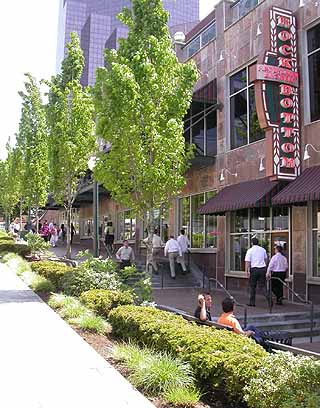
DJC.COM
June 29, 2006
Eastside bids adieu to its bedroom community image
First Mutual Bank

Valaas
|
The buzz over just exactly what is happening on the Eastside is growing louder as the construction cranes grow more visible again. If you haven’t driven or walked through downtown Bellevue in a while, you might not recognize it. What were once crater-sized holes on many corners of the city are now filled with office, retail and residential projects — and buildings continue to go up.
Many observers are calling it the long-predicted emergence of the Eastside as a far greater economic force in the state.
So what is really happening? The Eastside is transitioning from a bedroom community to an urban center, and the change has many implications for our businesses and the region.
Although the transition is happening rapidly, there is order to this growth. Decades ago, Bellevue developed the “wedding cake” plan, meaning taller buildings are concentrated in the central business district and gradually decrease in height as they approach the residential neighborhoods. This layout leaves residential areas within walking distance of the urbanized center. The plan miraculously survived several recessions and growth booms over the years, and we are now seeing it take shape.

Photo courtesy First Mutual Bank Projects such as the Galleria are turning Bellevue into a regional economic force. |
Over the economic bump
It hasn’t been an easy ride. The most recent economic bump to hit the Puget Sound region, particularly the Eastside, was the technology boom and bust. The boom sparked new life on the Eastside thanks to many high-tech companies, including Microsoft. Unfortunately that growth was not sustainable and the area in 2000 took a big downturn. That slump was a long one, lasting until 2005, according to the Bellevue Downtown Association.
That spark of life has ignited an apparent development wildfire on the entire Eastside. Businesses wanting to take advantage of the opportunity will benefit from looking at the elements that kindled it for some clues about how long it might last and where it might go. In my opinion, the most significant trends driving this growth are transportation and the emergence of retail shops, restaurants and entertainment venues, and jobs.
Transportation
Anyone who has driven on the region’s gridlocked streets and freeways won’t be surprised that transportation continues to be a hot topic. With the emergence of the Eastside come a variety of jobs, additional residential units, and diverse forms of entertainment that make it an appealing place to live.
More people were opting to avoid long freeway commutes by living and working on the Eastside, even before $3 a gallon gasoline. This transition has pushed Eastside home prices up and generated an assortment of new projects. Meanwhile, longtime owners of Eastside homes are selling and purchasing convenient downtown condominiums in Kirkland and Bellevue, driving up demand even more.
Entertainment
Bellevue and Kirkland’s retail areas reached critical mass with the recent addition of highly sought after restaurants, including McCormick & Schmick’s and Trader Vic’s in Bellevue, and Purple Café and Wine Bar in Kirkland. New entertainment venues such as Lincoln Square Cinema and the revitalization of the arts with the Bellevue Arts Museum and the Theatre at Meydenbauer Center also draw new visitors. These businesses attract people of all ages, driving business to surrounding stores.
Jobs
This increased popularity means more jobs for the area as companies relocate to the Eastside. Another factor attracting companies is the Eastside’s mix of highly skilled workers. It also means an enhanced ability to attract and retain younger employees.
Microsoft, for example, is a huge contributor to Eastside job growth, with 50 percent revenue growth in the last fiscal year. If a new company came to most towns with a plan to create 10,000 jobs while rebuilding its main campus, as Microsoft announced recently, it could demand millions in tax deferrals and subsidies and would be front-page news for months. Here, it is business as usual.
A lesser-known contributor to our growth is the video gaming industry, represented by Nintendo, Monolith and Crankypants. To help feed that industry with qualified candidates, DigiPen Institute of Technology, a four-year Bellevue-based college dedicated to the study and development of video games, recently opened.
But it isn’t only jobs in technology that have increased; retail and service jobs are also on the rise. Five thousand new jobs have been created downtown since 2000 — the completion of Lincoln Square created an estimated 775 new jobs in retail alone. Lincoln Square’s office tower now under construction is fully leased a year before completion thanks to Eddie Bauer and Microsoft.
An increase in jobs leads to an increase in growth, and there has been plenty of that on the Eastside. According to the Bellevue Downtown Association, downtown office vacancy rates made a swift and dramatic rebound from 30 percent just three years ago to 8 percent today. Approximately 1,800 housing units and 1.7 million square feet of business and office space have been added in Bellevue since 2000. And we’re not seeing an end to it. This year, construction will resume or ground will be broken on five office towers totaling 2.5 million square feet. That will add about 8,000 jobs to the market. And the cycle continues.
But it is a cycle. In fact, if we had seen normal growth rates each of the past five years, we might be about where we are today. So while we all enjoy and benefit from today’s ride, we need to stay on top of our competition and keep it in perspective.
Despite the inherent risks of bust-and-boom business cycles, there’s no going back to the days when the Eastside was a bedroom community. Trends in transportation and jobs and the emergence of critical mass have permanently propelled the Eastside into a position of much greater influence regionally and statewide. Just ask the Sonics.
John Valaas is president and CEO of First Mutual Bank.
Other Stories:
- Need a tenant rep for office leases?
- Saving historic buildings with tax credits
- Urban core too pricey? Try the U District
- Home buyers find downtown Tacoma less taxing
- Are we ready for Seattle’s pivotal moment in history?
- Will small businesses buy into condo offices?
- Smooth the development process by building trust
- Design quality is key in urban development
Copyright ©2009 Seattle Daily Journal and DJC.COM.
Comments? Questions? Contact us.